Bolognese, an artist of great talent who was able to carve out a non-secondary role for herself in early 16th-century Bologna, on the strength of an ingenuity that Giorgio Vasari described as “capricious and dextrous.” And woman: she is Properzia de’ Rossi (Bologna, c. 1490 - 1530), the first sculptor of whom we have record. Hers is an extraordinary story, the story of a woman who decided to try her hand at a craft hitherto reserved exclusively for males, the craft of sculpture, thus defying the conventions and value orders of her society and, at least according to what Vasari recounts, even going so far as to irritate some of her male colleagues. Of her, however, we know very little: the earliest document about her is a deed of purchase, dating from 1514, of a piece of land just outside Bologna, which would later be resold in 1516. Of her training we have no news: about her artistic career everything is silent until 1525, the year in which Properzia de’ Rossi began to work in the San Petronio building site in the Emilian city, alongside some of the greatest and most esteemed artists of the time, such as Alfonso Lombardi, Girolamo da Treviso, Amico Aspertini, and Niccolò Tribolo. Even the works referable to her with a good degree of certainty are very few: only three.
It is Vasari himself who has handed down to us the image of a strong woman, convinced of her own means, enterprising and independent: it is a portrait that is not just a literary invention of the great Arezzo historiographer, because some of Properzia’s character traits can be inferred from the documents we know of her life. Vasari, in presenting her figure, indulges in a long literary topos in which he first lists all the excellent women of antiquity and of his contemporaries, going so far as to say that women were “not ashamed, as if to twist us the boast of superiority, to put themselves with tender and very white hands into mechanized things and among the roughness of marble and lasprezza of iron, to achieve their desire and bring back fame.” And among the women who were not ashamed to put themselves to work in “cose mecaniche” is Properzia de’ Rossi, whom Vasari describes as a “virtuous young woman, not only in the things of the house, like the others, but in infinite sciences that not only women, but all men would envy,” and again as a woman “of beautiful body,” who “sonò e cantò ne suoi tempi meglio che femmina della sua città.” Vasari’s account continues with an anecdote, about which we have no records, but which is part of a tradition of stunning images that the historiographer often employed to emphasize the precocity of the talent of the protagonists of his Lives: indeed, it seems that Properzia had demonstrated her talents from a very young age by dabbling in carving peach pits, going so far as to create a Passion of Christ with this unusual and extravagant material, and succeeding in this art so well “that it was a singular and marvelous thing to see them,” not only “for the subtlety of the work, but for the quickness of the figurines she made in those and for the most delicate manner of compartmentalizing them.”
Scholar Vera Fortunati speculates that such a lively portrait might suggest that Vasari met Properzia in person: the occasion might have been the coronation of Charles V, which took place on February 24, 1530, in the basilica of San Petronio in Bologna, an event that drew to the Bologna city several artists involved in the staging of the scenes. “The encounter with a female presence so out of the norm,” Fortunati writes, “is destined to leave an indelible trace in Vasari’s memory, where admiration and censure are inextricably blended,” and the historian “does not hesitate to highlight the artist’s transgressive choice.” The choice is precisely to devote herself to a craft precluded to women, so much so that even later, in the mid-sixteenth century, at the height of the debate on the “comparison of the arts” (the discussion on the superiority of sculpture or painting, in which many artists and theorists took part), some, such as the man of letters Benedetto Varchi, the architect Francesco da Sangallo and the painter Paolo Pino, as arguments in favor of sculpture mentioned the absence of women sculptors, which, according to the mentality of the time, made sculpture a more difficult profession than painting, a field in which, on the other hand, several women were already working.
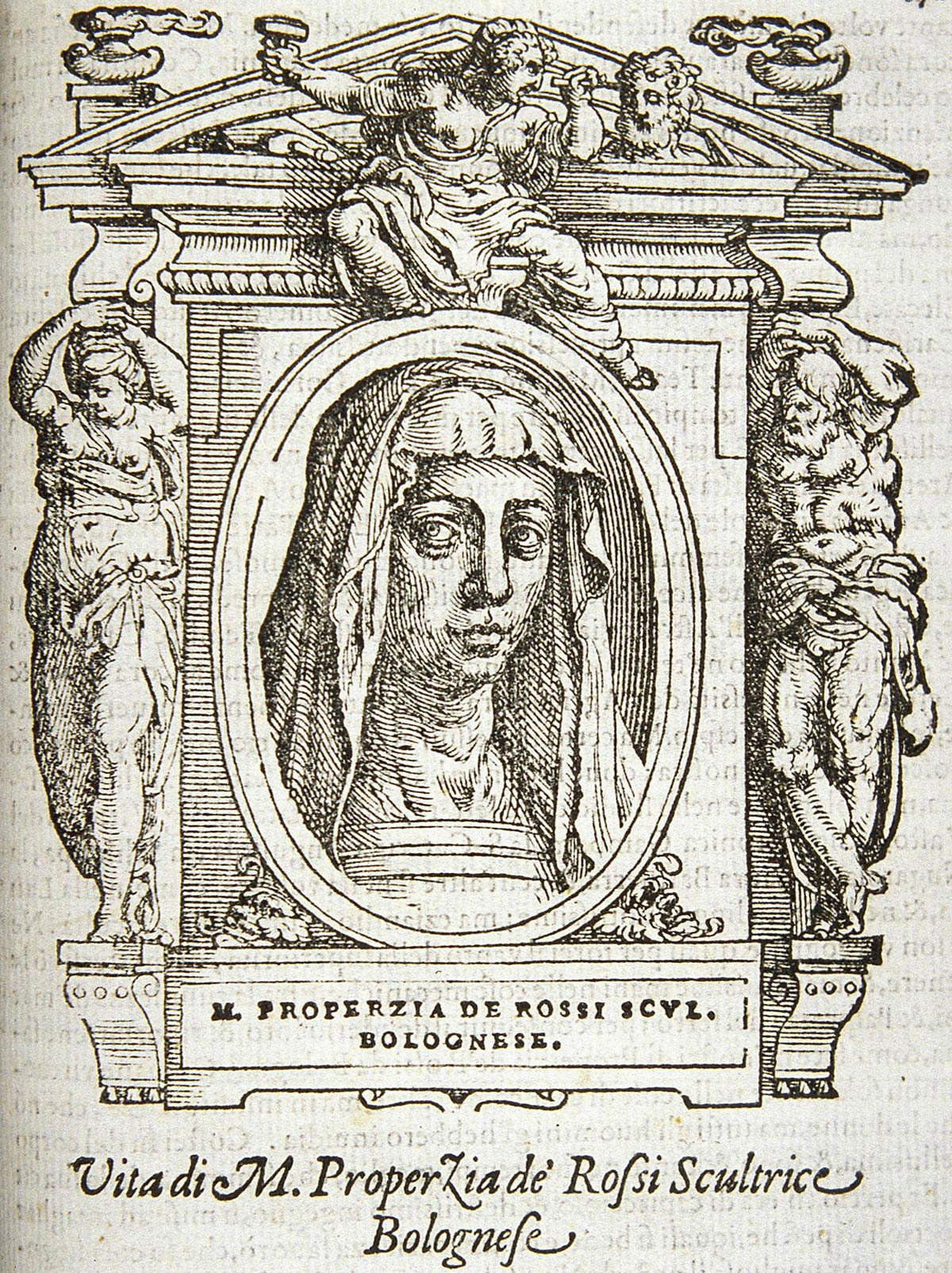 |
| Portrait of Properzia de’ Rossi in Giorgio Vasari, Le vite de’ più eccellenti pittori, scultori ed architettori, Florence, Giunti, 1568, p. 171 |
 |
| Ambito Bolognese, Female Portrait (Properzia de’ Rossi?) (16th century; oil on panel, 56 x 45 cm; Rome, Galleria Borghese) |
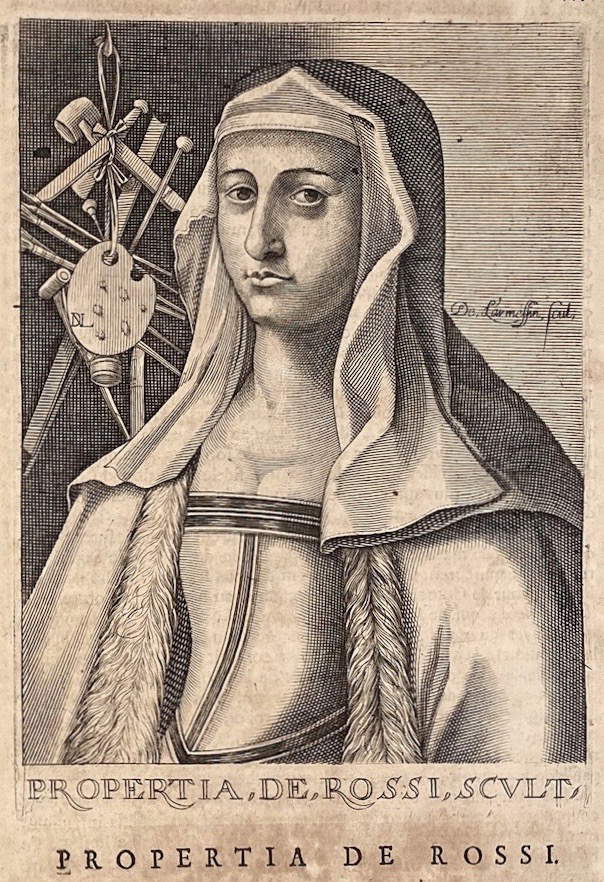 |
| Nicolas de Larmessin, Portrait of Properzia de’ Rossi in Isaac Bullart, Academie des Sciences, et des Arts contenant les Vies et les Eloges Historiques des Hommes illustres, Paris, Louis Blaine Marchand Libraire à la rue S. Jacques, 1682 |
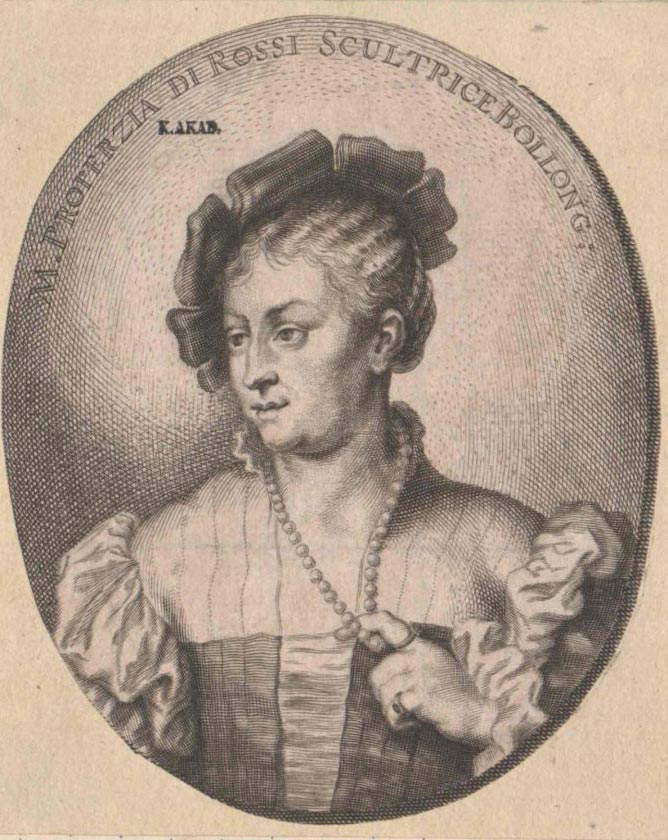 |
| Joachim von Sandrart, Portrait of Properzia de’ Rossi in Joachim von Sandrart, Academia nobilissimae artis pictoriae, Frankfurt, Michaelis ac Johan Friderici Endterorum haeredes, 1683 |
Properzia’s resourcefulness, as mentioned, is nonetheless supported by documents, beginning with those concerning the purchases and sales of her properties. The artist, after all, came from a wealthy family. It is worth a brief lunge on her education (which we can only assume, as no documents on the subject have reached us): her father Girolamo was a notary by trade (we have no information on her mother, however), and Properzia was probably initiated into the studies that typically followed young women from good families in the late fifteenth and early sixteenth centuries, which included religious education, learning elements of literature and practicing creative activities that were considered appropriate for the female sex (mainly embroidery and weaving). A minimal education, in essence: Properzia did not make it in time to be educated according to the principles that Baldassarre Castiglione listed in his Cortegiano (the first edition of which is dated 1528 and in which Castiglione sets the values according to which a lady should be educated: “I want this woman,” he wrote, “to have news of letters, of music, of painting, and to know how to dance and feast; accompanying with that discreet modesty and with giving a good opinion of herself still the other warnings that are taught to the courtier.”), but her case indicates that, probably, the notions she received during her childhood and adolescence exceeded, to some extent, the boundaries that the society of the time established for women, and evidently denotes that the position of women in the society of the time was undergoing very significant changes.
Returning to documents that can help give us an idea of Properzia’s temperament, we know for a fact that, in 1520, the sculptress was sued by a neighbor of hers, the Milanese Francesco di Stefano Crivelli, who accused her of having destroyed some plants (rows of vines and a cherry tree) in her garden, in complicity with her lover, the nobleman Anton Galeazzo Malvasia (so much so that in the acts of the trial Properzia is referred to as the latter’s “concubine”): on October 25, 1520, the two are accused of having cut down “viginti quatuor pedes vitium, et unum ciresum amarascum contra voluntatem dicti Francisci Velutarri Domini et Patroni dicti Orti” (“twenty-four feet of vines and a marasco cherry tree against the will of the said Mr. Francesco vellutaro, owner of the said kitchen garden”). The trial was then suspended, and we do not know how it ended, but the parties probably came to each other, because shortly afterwards Properzia bought the house in which Crivelli was living and rented it out to him (although later, on June 23, 1523, she intimated eviction). And again, there is one more document, which concerns a trial for a quarrel between artists that took place in 1525 (the painter Domenico Francia was accused of beating his colleague Vincenzo Miola). The only witness known to us is Amico Aspertini (Bologna, c. 1474 - 1552), Properzia’s main rival, at least according to Vasari’s account: in his deposition, Aspertini reported that the morning after the fight, having heard the commotion coming from the house of Miola, his neighbor, the artist had asked a woman who lived in Miola’s house what had happened the night before, and the latter allegedly answered him that “it was Domenico depentore del Franza, che ha dato al mio cristiano et glia amachato gli occhij, et la Propertia glia sgraffignato el volto.” Now, we do not know for certain whether the “Propertia” mentioned in the trial is the sculptress, but given the witness (Amico Aspertini her arch rival), and given that the quarrel had broken out in the artists’ quarter, it is quite safe to assume that the Propertia who had participated in the brawl, scratching her colleague’s face while Domenico Francia was beating him, is indeed our artist.
The only other documents we know of Properzia, however, concern her activity in the San Petronio building site. She began to be paid for her work on the building site starting in 1525: critics assume that it was Anton Galeazzo Malvasia, who was Pepoli’s friend, who recommended Properzia to the president of the Fabbrica di San Petronio, Count Alessandro Pepoli. Vasari, for that matter, reports that Properzia executed a marble portrait of Guido Pepoli (Alessandro’s father), which pleased the Workers of San Petronio so much that the Fabbrica decreed that the sculptress should join the site. An early 16th-century marble portrait is actually preserved in the Museum of San Petronio, the attribution of which to Properzia, however, is much debated partly because of the difficult identification of the person depicted. Properzia worked on the basilica’s building site until 1526 (the last news of her activity in San Petronio is from July of this year, which coincides with the last news about her artistic activity): Vasari reports a sort of mobbing that Properzia would have suffered from Amico Aspertini, since, according to the story, the rival artist, envious of her, would have spread bad rumors about her, with the result that the workers paid “a very low price” for her works. In reality, the payments Properzia received, at least according to the notes that have come down to us, do not reveal any major differences from those of her colleagues, however, argues art historian Massimo Giansante, Vasari’s account may not be fictionalized: “the sculptor’s outraged dissatisfaction and her voluntary departure from the site,” Giansante explains, “do, in fact, fit quite well into the picture sketched so far by the documentary sources, particularly with regard to Properzia’s intemperance and her predominantly confrontational relationships with other artists.”
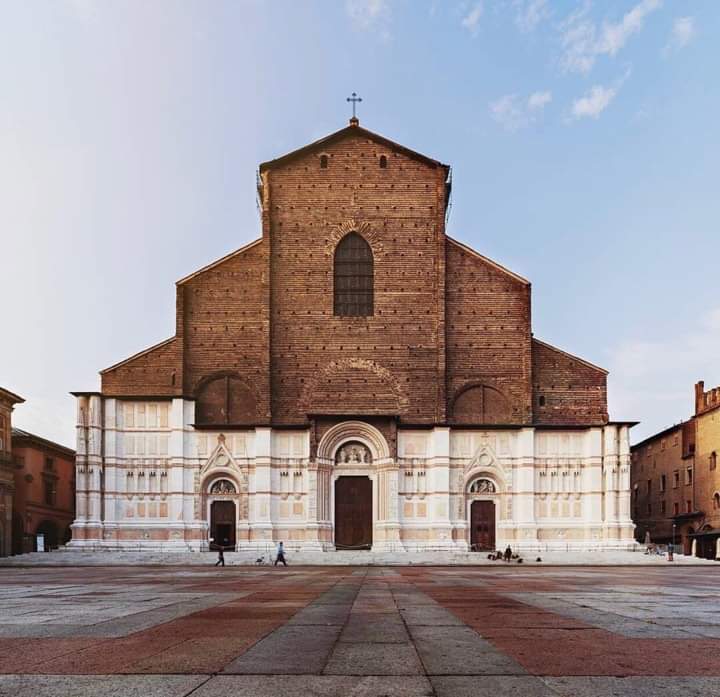 |
| Bologna, the basilica of San Petronio. Ph. Credit Fabbrica di San Petronio |
 |
| A room in the Museum of San Petronio |
As anticipated, there are only three works that can be referred with some certainty to Properzia de’ Rossi. The first is a tile with Joseph and Putiphar’s wife, which is moreover central to Vasari’s account, and is therefore the basis for any attempt to reconstruct the sculptor’s artistic activity. Indeed, Vasari speaks of a “leggiadrissimo quadro dove [...] fece la moglie del maestro di casa di Faraone, che innamatasi di Giosep, quasi disperata del tanto pregarlo, allultimo togliogli la veste dattorno con una donnesca grazia e più che mirabile.” According to the Tuscan historiographer, the work was “reputed by all to be beautiful et to her of great satisfaction, seeming to her with this figure from the Old Testament to have partly isfogato lardentissima his passion.” The episode is the one recounted in the book of Genesis: the patriarch Joseph, as a young man, is sold by his brothers as a slave in Egypt, and purchased by Putiphar, head of Pharaoh’s guards. Putiphar’s wife, attracted by the boy’s attractiveness and falling in love with him, tried to seduce him, but he broke free and fled: the woman, rejected, wanted revenge by slandering him (she told that he had wanted to rape her), which is why Putiphar had him imprisoned. In her marble relief, Properzia does not deviate from the usual iconography of the episode, adhering to the biblical narrative, and according to which Joseph is caught fleeing, and Putyphar’s half-naked wife, sitting on his bed, is depicted in the act of clutching Joseph by the robe (she tears a flap of it). In ancient times the relief was probably located above one of the portals of the facade, but Vera Fortunati and Irene Graziani speculate that, given its excellent state of preservation, the work has never been displayed outdoors. Fortunati has also related the depiction to Properzia’s personal vicissitudes (an unrequited love): “the identification with Putiphar’s wife,” she writes, “reflects a feminine interpretation of the biblical episode that is transcribed with a language updated on the models of the Roman ’manner’ and at the same time with an attention at times reserved for the natural datum.” The result is a space “calibrated in a harmonious sequence of verticals and horizontals,” where the main protagonist is not Joseph, but precisely Putifares’ wife, the female figure delineated according to Michelangelo’s models (as opposed to the young man who is instead exemplified on Raphaelesque modes). Fortunati thus speaks of a “refining of Michelangelo” that led Vasari to give that definition of “leggiadrissimo quadro.” And it seems that Parmigianino was also fascinated by this tile, precisely because of the unusual female point of view.
The relief has been related to the similar episode depicted in Raphael’s Loggia in the Vatican, which is traditionally attributed to Giulio Romano (Giulio Pippi de’ Iannuzzi; Rome, c. 1499 - Mantua, 1546): Properzia could get to know it through the graphic redaction rendered in an engraving by Marcantonio Raimondi (Sant’Andrea in Argine, 1480 - Bologna, 1534), who was Bolognese like her. And on the basis of this faint foothold, Properzia’s training at Raimondi’s workshop has also been hypothesized: information that is, however, still impossible to verify.
The second work is referable to the same commission: in fact, it is another bas-relief, depicting the episode of the accusation made by Putifares’ wife against Joseph. It is a work that is mentioned much less in historiography than the one depicting the episode of the temptation, so much so that in the past it was also attributed to Amico Aspertini. Already in a guide Pitture, scolture ed architetture delle chiese, luoghi pubblici, palazzi, e case della città di Bologna, e suoi sobborghi of 1776, the tile is juxtaposed with others judged to be “of a more resentful manner” than the bas-relief always assigned to Properzia’s hand. The first attribution to Properzia of this tile dates back to 1832 (Antonio Saffi is credited with having recognized her hand in it), and after a debate that continued throughout the twentieth century, critics settled on an assignment to Properzia, although in 1984 Maria Vittoria Brugnoli attributed the design to Alfonso Lombardi, recognizing the execution as the work of the sculptor: this was for reasons of stylistic proximity to the Moses and the evidence of the burning coals that Lombardi sculpted for the left portal of San Petronio. After all, the accounting records of the fabbriceria of San Petronio show that Properzia on certain occasions was employed to give form to the designs of others (and among the sculptors whose ideas she translated was Lombardi himself).
The third work is a singular work of goldsmithing: it is the coat of arms of the Grassi family, a work in silver filigree, rock crystal and boxwood (the latter being particularly suitable for works of this kind by virtue of its hardness), in which are set twelve carved apricot pits, with figures of saints, two on each side of the pit. It is precisely the extravagance of the carved fruit stones that has led critics to ascribe the work to the hand of Properzia de’ Rossi (except for the mount: in fact, we do not know of any goldsmith activities possibly conducted by Properzia, which is why we tend to assign the metal parts to the brothers Giacomo and Andrea Gessi, Bolognese goldsmiths of the early 16th century who worked for the Grassi family), recalling Vasari’s account of Properzia’s great skill in this type of work. Nineteenth-century art-historical literature has devoted considerable attention to this work, now housed in the Museo Civico Medievale in Bologna. The work, Fortunati writes, “undoubtedly belongs to a production of filigree artifacts intended for cult worship for an aristocratic patronage and collecting of refined workmanship: the vibrant and luministic treatment of the surface, the material entangled in a tangle almost as if to restore the soft effect of plumage frame the eleven hazelnuts, in which seems to pour a taste for the ’antique’ indebted to collecting interests related to epigraphic and numismatic finds, widespread in Bologna in the circles between court and Studio at the beginning of the sixteenth century.” In these reliefs, the scholar concludes, “calligraphic grace and optical evidence seem to mingle in the experimentation of a language that combines the lesson of classicism with the first formal ’transgressions’ of the ’manner.’”
 |
| Properzia de’ Rossi, Joseph and the Wife of Putiphar (1525?; marble, 53.5 x 54 cm; Bologna, Museo di San Petronio) |
 |
| Properzia de’ Rossi (attr. ), La moglie di Putifarre accusa Giuseppe (1525?; marble, 53 x 54 cm; Bologna, Museo di San Petronio) |
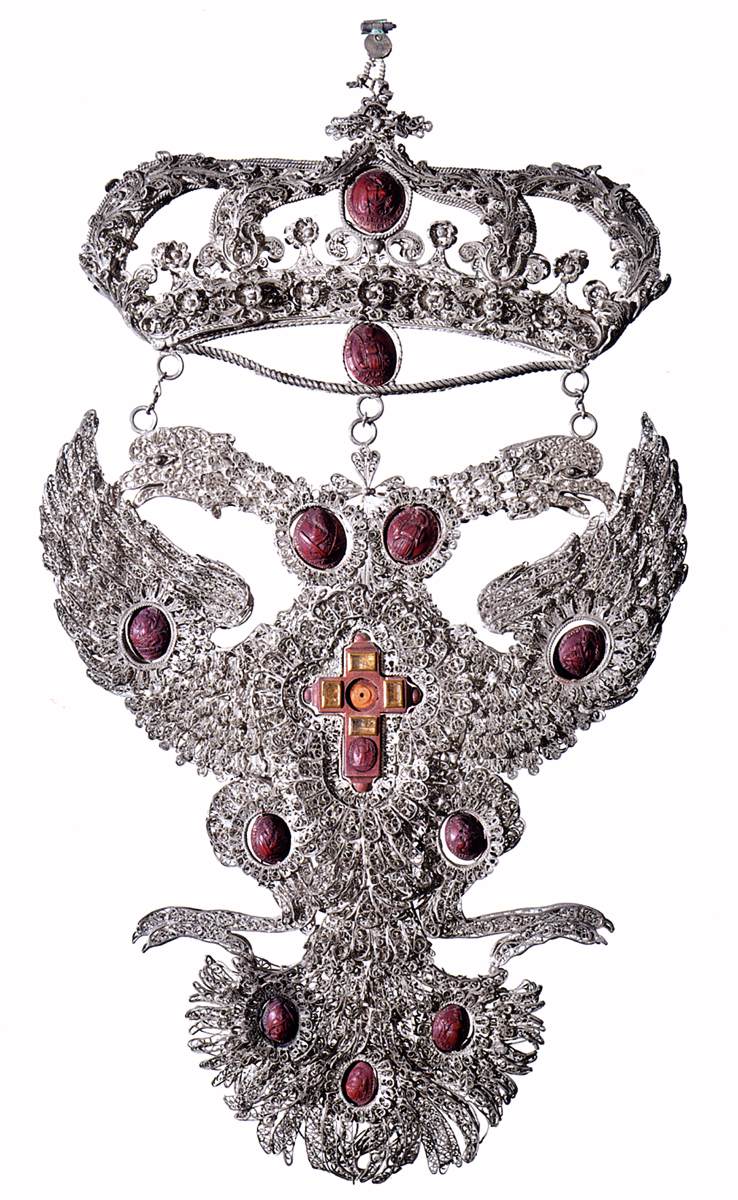 |
| Properzia de’ Rossi and Giacomo and Andrea Gessi (attr. ), Coat of Arms of the Grassi Family (q.d.; silver filigree, cast parts, rock crystal, boxwood, hazelnuts, 39 x 22 cm; Bologna, Museo Civico Medievale, inv. 2135) |
 |
| Properzia de’ Rossi, Coat of arms of the Grassi family, detail with the figure of St. Peter |
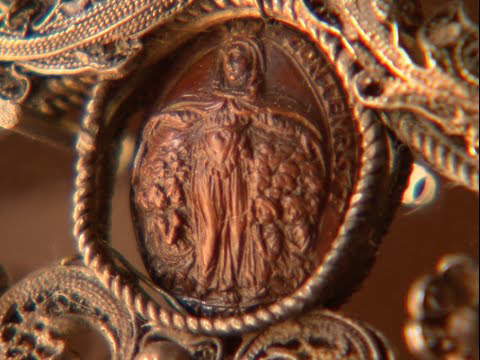 |
| Properzia de’ Rossi, Coat of arms of the Grassi family, detail with the figure of Our Lady of Mercy |
The last certain news about Properzia concerns the final part of her life: in April 1529 we know that she was admitted to the hospital of San Giobbe, ill (a document of hers in which she arranged for the payment of a debt to a notary, Lorenzo da Massummatico, dates from this time). Properzia thus continued to pursue her economic activities until the end of her days, which probably came in February 1530 (this is the date provided by Vasari). Giorgio Vasari has also handed down to us the classic image of Properzia: “her portrait,” he writes in the Lives, “has been had by some painters who were her closest friends.” The image Vasari speaks of is the one that accompanies the “Life” of Properzia, and which shows her to us half-length, turned three-quarter-length, and with her head veiled, according to a custom rather common among the women of good families of the time. This is the most widely taken image of Properzia, and the fine portrait of Bolognese scope that is now in the Galleria Borghese in Rome is probably also based on this type (we do not know, however, whether this is really Properzia’s portrait, since it lacks attributes that would identify the woman’s trade).
However, there are also some portraits that perhaps better communicate the character and pride of this exceptional woman, both published in print, and within a short distance of each other. The first was engraved by Nicolas de Larmessin (Paris, 1632 - 1694) as an illustration for Isaac Bullart’sAcademie des Sciences, et des Arts contenant les Vies et les Eloges Historiques des Hommes illustres, a treatise published in 1682. Here, Larmessin, while following Vasarian connotations, offers a decidedly more feminine image of Properzia, with her low-cut robe, fur-trimmed mantle, and ornate bodice, and above all more proud, as she is accompanied by the typical tools of the trade, namely the chisel, hammer, and square, as well as a palette and brushes. The most feminine Properzia, however, is that of Joachim von Sandrart (Frankfurt am Main, 1606 - Nuremberg, 1688), used to illustrate theAcademia nobilissimae artis pictoriae, written by Sandrart himself: here, Properzia is transformed, as Irene Graziani has written, “into a lady of the aristocracy posed according to the code of the international portrait [....]: the fingers of the hand entwined in the vein of pearls, the dress of light fabric moved in the play of the bulging sleeves, the bonnet with open corolla brim on the hairstyle of wavy hair, gathered at the nape of the neck, but free in small locks around the forehead.” A “lithe and elegant” face that, in Sandrart’s guide, also has a record: in fact, Properzia de’ Rossi is entitled to first place in the review of illustrious Italian women artists. At the head of a valiant array of women who would include, in the years and centuries to come, the likes of Plautilla Nelli, Sofonisba Anguissola, Artemisia Gentileschi, and so many others.
Warning: the translation into English of the original Italian article was created using automatic tools. We undertake to review all articles, but we do not guarantee the total absence of inaccuracies in the translation due to the program. You can find the original by clicking on the ITA button. If you find any mistake,please contact us.